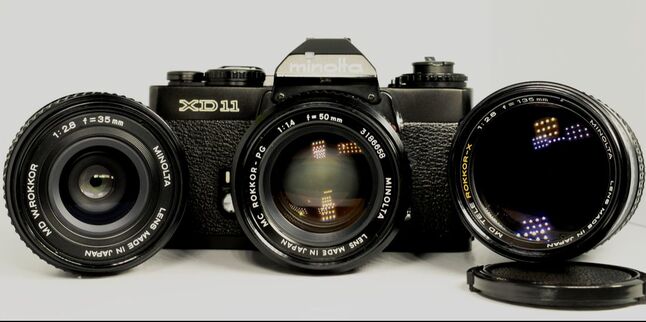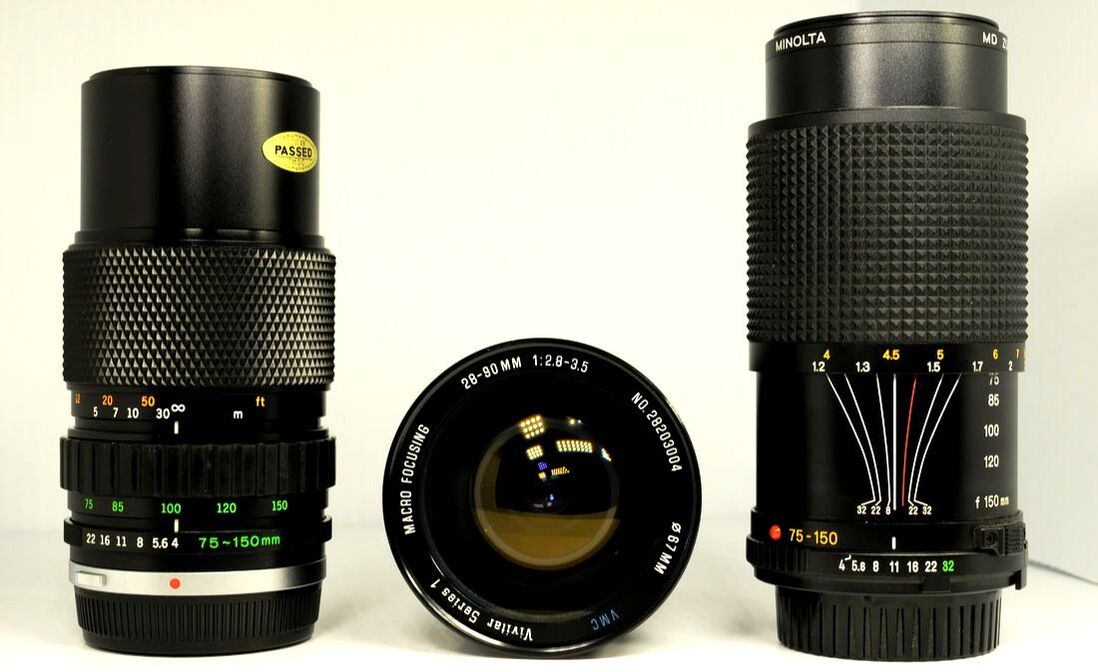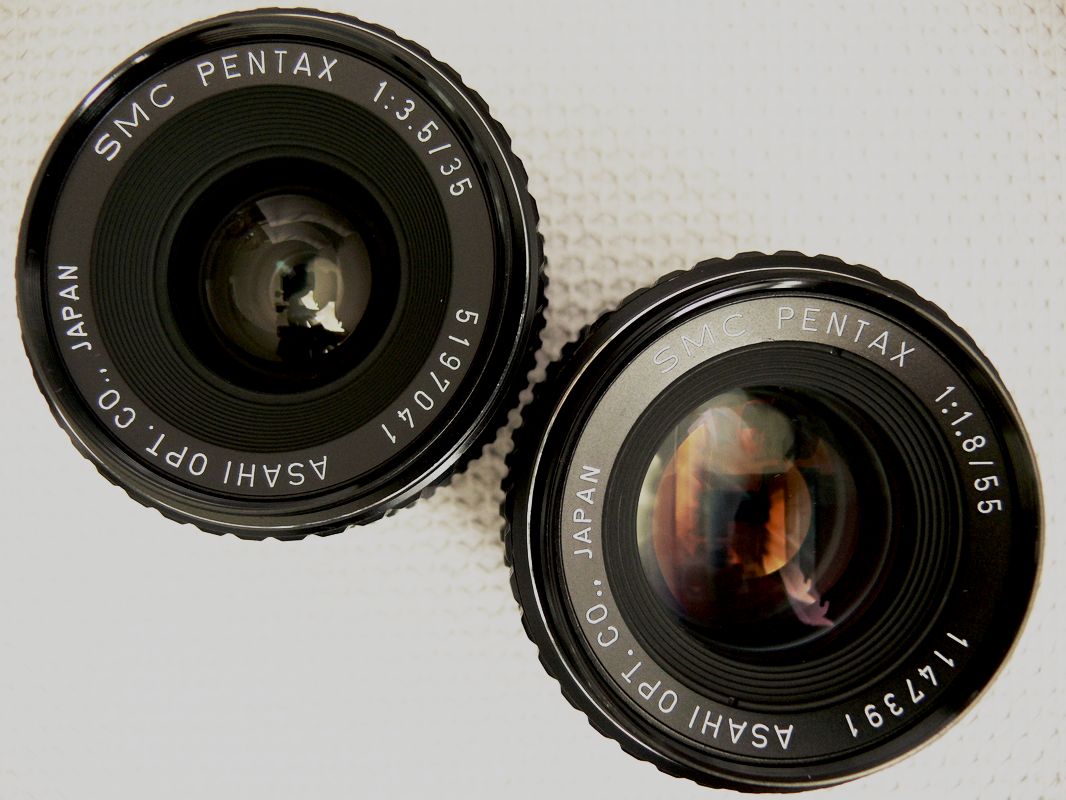|
"...this splendid Volkswagen Beetle of SLRs..." -- Herbert Keppler, Oct. 1989 -- In a word...Possibly. Does that make it a terrible camera? Nope. Does it mean that you shouldn't buy one? Not necessarily ;-). But before getting sucked in by all of the Interweb-mongering of the K1000 as the best beginner SLR...of...all...time, it may be worth your while to investigate where it stacks up in relation to other vintage 35mm SLRs (many of which can be had nowadays for the same or considerably less in terms of monetary outlay) and how it came by its popularity among newbs in the first place. Let's start with the latter.
16 Comments
Updated Mar. 8, 2024 So where does our fixation with Top Ten Lists come from, anyways? Letterman? The Ten Commandments? Well, if you can't beat 'em.....Here, for your casual perusal, is a chronological consideration of ten important Japanese SLRs that pushed the development of such cameras forward for over 30 years. This is not to say that these are the 10 "top" or "best" SLRs of all time (far be it for me to be the arbiter of such things ;-)), and some may be less familiar than others, but all of them had an undeniable effect on the industry or market as a whole. Let's dive in :-).  1981 saw some major technological milestones: the first manned orbital mission of the Space Shuttle...the debut of IBM's Personal Computer (aka the PC)...the first flight of Boeing's second-gen wide-body, the 767...and the first Delorean DMC-12s began to roll off the line in Ireland. In step with such advancements, Pentax sought to push the technological boundaries of the 35mm SLR, much as they had a decade earlier with their Electro Spotmatic (ES) aperture priority autoexposure model. Only this time it was focus rather than exposure that they were seeking to automate. In late-'81, the ME F would become the first production 35mm auto focus (AF) SLR (with a caveat ;-)) to hit the scene. Updated Oct. 1, 2022 There, there, Pentax Nation. Your clickbait detectors just needed a little recalibration, that's all. As for your well-known inferiority complex, there is only so much one article can do, but I'll give it my best effort ;-). All kidding aside, we are going to take a closer look at my favorite Pentax SLR, Nikon-tainted as it may be, and how it came to be so. Updated July 23, 2020 PROGRAM...the buzzword for SLRs in the early 1980's. Only with this technological breakthrough could photographers now surmount the barrier of having to think about camera settings and composition at the same time! Freedom from Aperture- or Shutter-priority or (heaven forbid you were still using) m...mm...mmm...Manual exposure beckoned. At last, focus (no pun intended) only on composition...unencumbered by such banalities...and our wunderkamera will do it all better than you ever could, anyways...(Okay, okay, that's enough...1980's marketing-speak now set to OFF). Riiight. Anyhoo, Program was going to be the next big thing to save the Japanese manufacturers from the the slippery slope of the latest SLR sales slide (Aside: it didn't ;-)). From the introduction of the Canon A-1 (1978), the first proper Program mode SLR (along with the three more familiar exposure modes mentioned above), to the 1985 introduction of the real "next big thing" (Auto Focus), the profligate proliferation of Program SLRs only accelerated. Followers included: Fujica's AX-5 (1979), Canon's AE-1 Program (1981) & T50 & T70 (1983 & '84), Minolta's X-700 (1981), Nikon's FG & FA (1982 & '83), Olympus' OM-2S & OM-PC/OM-40 (1984 & '85) , Ricoh's XR-P (1983), Yashica's FX-103 Program & the Contax 159MM (1985), and the two subjects of this article: the Pentax Super Program (1983) and Program Plus (1984). That's 16 models within seven years. So what set the Pentaxes apart from the rest of their competitors? Read on at your leisure ;-). In automotive circles, the "sleeper" has a long and roguish history. Take a plain-Jane car and throw some serious performance bits under the hood and prey upon the unsuspecting (bwahahaha). A frumpy four-door with a quiet (at least at idle) exhaust makes it even tastier :-). When it comes to old SLRs, there is no such post-purchase hopping-up per se, but there were enough models that followed the spirit of the sleeper as far as looks and features went to make things interesting. The bonus today is that you can snag one of these soporific snappers for a fair bit less than their more-celebrated contemporaries, while giving up very little (if any) outright performance. Now, if I happen to leave out your favorite flies-under-the-radar film-burner, don't get uptight. Feel free to mention my misses in the comments, and who knows, maybe we will have to do a sequel. So...in no particular order... Just sit right back and you'll hear a tale, a tale of a fateful slip that happened to three companies who thought they were so hip... In Part 1, we focused on Pentax, Olympus, Nikon, and Minolta, respectively, as the first companies to introduce production auto focus (AF) 35mm SLRs in the early to mid-1980s. Although Pentax was the first-mover (1981), and Olympus & Nikon followed two years later, it was not until the introduction of the trendsetting Minolta 7000 in February 1985 that the AF SLR truly came of age. This was borne out by the other three manufacturers' abrupt decision to adopt Minolta's idea of AF motor-in-body (MIB) design, abandoning their previous allegiance to the motor-in-lens (MIL) philosophy. These companies' next AF SLRs bore an uncanny resemblance to the all-conquering 7000, at least in the lens mount area ;-). Minolta appeared poised to dominate SLR sales for the foreseeable future, yet within three years, they would be toppled from the peak and by the time the early-'90s rolled around, they would be back in their familiar third-place sales position that they had held from the early-'70s onward. So, even being the first successful AF SLR manufacturer was no guarantee of being the long-term winner. How could that happen? This time, we will take a closer look at the reaction to the AF revolution by the then-biggest fish in the SLR pond. Updated May 2, 2022 In the land of manual focus SLRs circa 1984, things were looking grim. That old implacable foe, "market saturation", had once again surfaced from the depths of the eastern Pacific to wreak havoc on the sales charts of the Japanese manufacturers. Over a decade had elapsed since its previous appearance in the early to mid-'70s. The proliferation of affordable autoexposure SLRs, from 1976 onwards, had not only blunted that attack, but had then led to the greatest sales extravaganza for 35mm SLRs, EVER. But now, the denizen of the deep was back with a vengeance and taking names. Internal motors for film advance, LCD displays, and angular '80s styling were doing nothing to stem the tide. Only another big-time innovation was going to give the SLR makers a chance. Their trump card? I don't know if Rodney Dangerfield was into photography, but if he was he must have used f/3.5 lenses, judging by the way he was always bugging his eyes out. Which would be understandable, because any half-baked photographer knows that f/3.5 is a raging vortex where photons go to die, leaving your eyes straining for the faintest trace of light. Not to mention the utter impossibility of achieving anything remotely resembling shallow depth of field (DOF) with such an infinitesimal iris. No proper lens jockey would be caught dead with such a miserable excuse for a photographic tool. So if you have any remaining shred of photographic self-respect, let me save you the trouble now of reading any further ;-). Welcome to the final installment of our "Choosing Manual Focus Lenses" series. In this article, we will look at the larger picture of lens sets in general and also check out a few options for specialty optics, such as macros and shift lenses.
Zoom lenses really started to come into their own by the late-1970s and became standard equipment with most SLRs by the mid-'80s. Versatility was the name of the game, with such optics sometimes enabling a photographer to replace up to 3 primes with one lens. However, this was not a free lunch; there were always compromises involved. Welcome to Part 2 of Choosing Manual Focus Lenses. We will now delve deeper into the categories of focal lengths and the differences between them. As in the previous post, we will be looking at this in terms of vintage 35mm format manual focus (MF) lenses, but you can use the principles for more modern glass and other formats. WARNING - There may some numbers involved! (I'll try to control myself ;-)) Fun With Focal Lengths In 35mm format: "Normal" lenses range from 40 - 58mm (with 50mm being by far the most common and was the basic kit lens offered with SLRs for years); Wide-angles go from about 28 - 35mm; Extreme wide angles from 15 - 25mm; Ultra-wide angles are less than 15mm; Telephotos from 65 - 300mm; and Super Telephotos are greater than 300mm. All of these categories are approximate, but you get the general idea. We will look at single focal-lengths and, in the next article, discuss how zooms combine several focal lengths into one lens and the advantages/disadvantages of doing so. One of the most daunting experiences for an SLR owner can be deciding which lenses to choose to achieve their photographic goals. The sheer number of possibilities can seem overwhelming when trying to narrow things down to a manageable kit, both expense- and weight-wise. Further complicating matters is that what works well for someone else may be entirely different than what will be best for you. Choosing lenses goes beyond mere quantitative measurements. Your aesthetic sense of how you see the world around you, along with the genres of photography you pursue, and the conditions you will be working in all have a direct bearing on which lenses will be most suitable for you. Too many of us have learned the hard way about which lenses are best suited to our needs and abilities. Trial and error does often eventually lead us to the right conclusions, but with a considerable amount of wasted time, energy, and MONEY. Could there be a better way? Updated May 3, 2022 Here is the second part of the fifth entry in our "Choosing a Vintage SLR System" series for manual focus SLRs. In Part #1 we looked at the Pentax M42 screwmount system. Pentax was the last of the "Big 5" (Canon, Minolta, Nikon, and Olympus being the others) to adopt a bayonet-style lensmount, doing so in 1975. The K-mount has continued to serve (in modified form) into the digital era. For now we will confine ourselves to the manual focus film era. So let's get to it with our standard format of: 1) Lenses, 2) Bodies, 3) Flash, 4) Accessories, and 5) Reliability & Servicing. Updated Apr. 27, 2022 Greetings, and welcome to our fifth vintage SLR system overview, this time featuring Pentax (or Asahi Optical Co. as they were originally known). In this installment we will examine their first SLR system, which (aside from the Asahiflex models) utilized the M42 screwmount introduced by Zeiss in 1949. Over time, such was their success, M42 became commonly referred to as the Pentax screwmount. The M42 mount was used by Pentax for 20 years (1957-76) and today represents one of the most affordable and accessible SLR systems available to the vintage-focused photographer. In the second part of our Pentax overview, we will dig into the bayonet-style K-mount system introduced in 1975, and which is still used (in a modernized electronic form) by Pentax. As usual, we will break things down by: 1) Lenses, 2) Bodies, 3) Flash, 4) Accessories, 5) Reliability & Servicing. With a major SLR slump under way, the early-to-mid-1980s were the golden age of the compact AF (auto focus) 35mm camera. Many snapshooting consumers, who had been sucked in by the snake-oil promise of SLRs that did everything for you, now turned to what they had really needed all along: relatively affordable compact AF models. Innovations were coming fast and furious, and widespread cost-cutting had yet to enter the picture. All of the major (and most of the smaller) manufacturers had at least one high-quality entrant in the hotly-contested 35mm f/2.8 category. By the late '80s, however, the bean-counters and the public's clamor for zoom lenses ensured the demise of the capable, yet economical, AF compact. But let's go back to the boom days of... The mid-1970s were a time of major transition in the SLR industry. The biggest changes involved the downsizing of camera bodies (initiated by Olympus), the general electrification and computerization of many functions (most notably with the Canon AE-1), and the inevitable de-contenting and cost-cutting that came with increased competition between all manufacturers for market share. Perhaps no series of SLRs demonstrated being caught in this no-man's land more than the first three models Pentax released with its brand-new K-mount bayonet in 1975. Two models would survive only two years, the third only five. Yet, ironically, the fourth model, introduced in 1976, would go on to be one of the most successful and iconic of all SLRs and would be in production for over 20 years. Fortunately for vintage camera lovers, any of these K-series SLRs can still be enjoyed and are serviceable even today. So let's take a look at the tragic trio of the KM, KX, K2, and the student camera extraordinaire, the K1000. Updated Apr. 27, 2022 Domination of the mid-to-late 1960's sales charts. Millions of devoted fans. As influential on SLR development as a certain group of four blokes were on rock 'n' roll during the same period. We can only be talking about one camera...the Pentax Spotmatic (or Spottie to its ardent admirers), the first true superstar SLR. This is the first installment of our Best Bargain Lenses series in which we attempt to sift out the truly best-bangs-for-your-buck in the legacy lens world. We are starting with the Pentax K-mount (bayonet) because of increased interest in vintage Pentax glass since the release of the new K-1 full-frame (35mm format) DSLR. You will find that most bargains lie in the focal lengths between 28 to 200mm and at moderate apertures (e.g. f/3.5 or f/4 for wide angles and telephotos and f/1.7 to f/2 for normal lenses). The beauty of these unassuming optics goes beyond their low prices; because of their smaller maximum apertures they were able to use simpler (most of the time) optical constructions, which saved weight and bulk and yet gave excellent performance. So let's start the party with the original series of Pentax K-mount lenses: the SMC Pentax models which were manufactured from 1975 to 1977 (offering the best build quality before cost-cutting entered the picture with the M- & A-series). As we go through we will consider each lens in context with its predecessor in M42 screwmount and successor in SMC-M. Prices are current as of 2016 and are an average cost for lenses in very good to excellent condition. |
C.J. OdenbachSuffers from a quarter-century and counting film and manual focus SLR addiction. Has recently expanded into 1980's AF point and shoots, and (gack!) '90s SLRs. He even mixes in some digital. Definitely a sick man. Categories
All
Archives
June 2024
|













 RSS Feed
RSS Feed